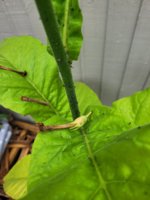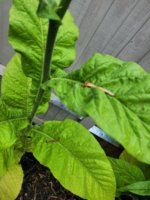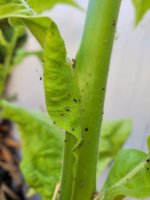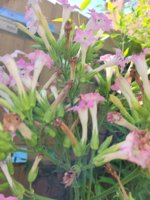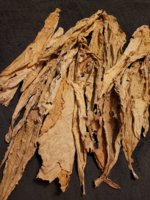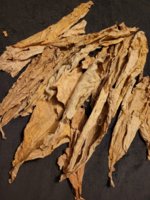You are using an out of date browser. It may not display this or other websites correctly.
You should upgrade or use an alternative browser.
You should upgrade or use an alternative browser.
Bramleyjordan Grow Log 2021
- Thread starter Bramleyjordan
- Start date
- Status
- Not open for further replies.
If they have not pollinated, then they sometimes just drop off.
Bob
Bob
Bramleyjordan
Well-Known Member
Okay so I guess they get pollinated by insects?If they have not pollinated, then they sometimes just drop off.
Bob
Tobacco is mostly self-pollinated (nearly 90%). The remainder of the pollination is by insects.
Bob
Bob
Bramleyjordan
Well-Known Member
Great thanks. It's normal for them to drop off then? Still loads on there just would like some seeds for next yearTobacco is mostly self-pollinated (nearly 90%). The remainder of the pollination is by insects.
Bob
One fat seed pod should give you thousands of seeds.
Bob
Bob
Is the black stuff on the leaves tiny insects or worm castings? Look thoroughly for signs of bud worms. One of the photos in the uky article shows the scat.I keep seeing the seed pods falling off the plants, I know they are not ready yet for seeds but wondering if its normal for some to fall? Possibly happening in wind/rain
Budworm | Burley Tobacco Extension
Budworms are often difficult to kill due to protection from the bud. Damage to small bud leaves can be significant if budworm infestation is high. Buds can be damaged beyond recovery by budworms.
This one shows the pod under attack
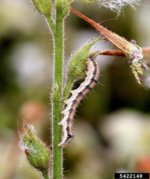
Bramleyjordan
Well-Known Member
They all seem to be tiny insects getting stuck on the sticky leaves and stalk, I tried to get some close and personal hq pics for youIs the black stuff on the leaves tiny insects or worm castings? Look thoroughly for signs of bud worms. One of the photos in the uky article shows the scat.
Budworm | Burley Tobacco Extension
Budworms are often difficult to kill due to protection from the bud. Damage to small bud leaves can be significant if budworm infestation is high. Buds can be damaged beyond recovery by budworms.burleytobaccoextension.ca.uky.edu
This one shows the pod under attack
View attachment 37429
Attachments
Gnats.
Bramleyjordan
Well-Known Member
Yep I thought the same! Don't think they've damaged the plants thoughGnats.
Bramleyjordan
Well-Known Member
My process at the moment is as follows:
- Wait until leaves are 70-80% yellow then harvest.
- Hang the leaves in my shed until 95%+ yellow
- Hang the leaves in my house with a fan on the until dry and steam snaps
- bring to low case and store in vacuum style bag which is closed by folding and pegging.
- once all leaves are in the bag, I will put in the kiln for 4 weeks minimum
Does the above sound like an OK process?
Cheers
- Wait until leaves are 70-80% yellow then harvest.
- Hang the leaves in my shed until 95%+ yellow
- Hang the leaves in my house with a fan on the until dry and steam snaps
- bring to low case and store in vacuum style bag which is closed by folding and pegging.
- once all leaves are in the bag, I will put in the kiln for 4 weeks minimum
Does the above sound like an OK process?
Cheers
Alpine
Moderator
Leaves should be at 75% relative humidity when kilned, if you seal them in low case in a plastic bag the process may take much longer than the usual 4 to 5 weeks to complete. It is a good idea though, as it allows you to omit the filling of the crockpot once or twice a week (depending on how tight is your kiln). I would bag the leaves in medium/high case. No fear of mold, since the temperature in the kiln (52 to 54 deg C) prevents mold growth.
pier
pier
Bramleyjordan
Well-Known Member
Thanks for your reply but the leaves that are in the bag now are not in the kiln. They are just placed In a dark area waiting until the whole harvest is complete.Leaves should be at 75% relative humidity when kilned, if you seal them in low case in a plastic bag the process may take much longer than the usual 4 to 5 weeks to complete. It is a good idea though, as it allows you to omit the filling of the crockpot once or twice a week (depending on how tight is your kiln). I would bag the leaves in medium/high case. No fear of mold, since the temperature in the kiln (52 to 54 deg C) prevents mold growth.
pier
I am keeping them in low case since mold could grow if any higher. The kiln will be at 75%.. ish
Bramleyjordan
Well-Known Member
Is it best to separate the leaves as they come off the plant? E.g keep bottom ones separate to the top?
My plan was to mix them all together but have been hearing its different flavour throughout the plant.
Thanks
My plan was to mix them all together but have been hearing its different flavour throughout the plant.
Thanks
For at least your first year of harvesting, separating the priming levels will allow you to learn the differences. Eventually, you may want to do that for convenience, though you will be able to recognize the priming level of leaf in mixed bag.
Bob
Bob
Bramleyjordan
Well-Known Member
Thank you!
Here is a pic of my leaves so far. Sitting waiting for harvest to be complete before kilning! Do they look good to you? It's so much different from my indoor grow! The texture is thick and the aroma is very nice!
Here is a pic of my leaves so far. Sitting waiting for harvest to be complete before kilning! Do they look good to you? It's so much different from my indoor grow! The texture is thick and the aroma is very nice!
Attachments
Bramleyjordan
Well-Known Member
When you say priming levels, do you mean at different nodes? I'm not sure what priming level meansFor at least your first year of harvesting, separating the priming levels will allow you to learn the differences. Eventually, you may want to do that for convenience, though you will be able to recognize the priming level of leaf in mixed bag.
Bob
In the obtuse world of traditional, tobacco nomenclature, harvesting tobacco by the removal of individual leaves (starting from the lower stalk, and moving upward as they mature) is called "priming". If it were an apple or pear, it might be called "picking". With commercial cigar tobacco, priming levels can be roughly equated with volado, seco, viso, ligero, corona.
When I bother to separate priming levels, I generally mark them as "mud", "lower", "mid", "upper", "tips". But as I feel more comfortable with mostly stalk-harvesting most of my tobacco varieties, and curing them on the stalk, the leaf just ends up all mixed into a large bag labeled "stalk". If I want darker leaf for a particular use, I just rummage through the big bag, and find a darker leaf.
Bob
When I bother to separate priming levels, I generally mark them as "mud", "lower", "mid", "upper", "tips". But as I feel more comfortable with mostly stalk-harvesting most of my tobacco varieties, and curing them on the stalk, the leaf just ends up all mixed into a large bag labeled "stalk". If I want darker leaf for a particular use, I just rummage through the big bag, and find a darker leaf.
Bob
Bramleyjordan
Well-Known Member
Thank you sir. I think I'll just pick them and mix them togetherIn the obtuse world of traditional, tobacco nomenclature, harvesting tobacco by the removal of individual leaves (starting from the lower stalk, and moving upward as they mature) is called "priming". If it were an apple or pear, it might be called "picking". With commercial cigar tobacco, priming levels can be roughly equated with volado, seco, viso, ligero, corona.
When I bother to separate priming levels, I generally mark them as "mud", "lower", "mid", "upper", "tips". But as I feel more comfortable with mostly stalk-harvesting most of my tobacco varieties, and curing them on the stalk, the leaf just ends up all mixed into a large bag labeled "stalk". If I want darker leaf for a particular use, I just rummage through the big bag, and find a darker leaf.
Bob
That's a prime idea!Thank you sir. I think I'll just pick them and mix them together
Bob
- Status
- Not open for further replies.
-
About Us
This forum is dedicated to promoting the American tobacco farmer and tobacco home growers across the globe. Whether you grow by the acre, in your backyard, or in pots, you should find valuable and accurate information here.We discuss any variety of tobacco, as well as numerous approaches to growing, harvesting, curing, and finishing your crop. Our members will attempt to provide experience-based answers to your questions.
-
Buy raw tobacco from our Sponsor - WLT


